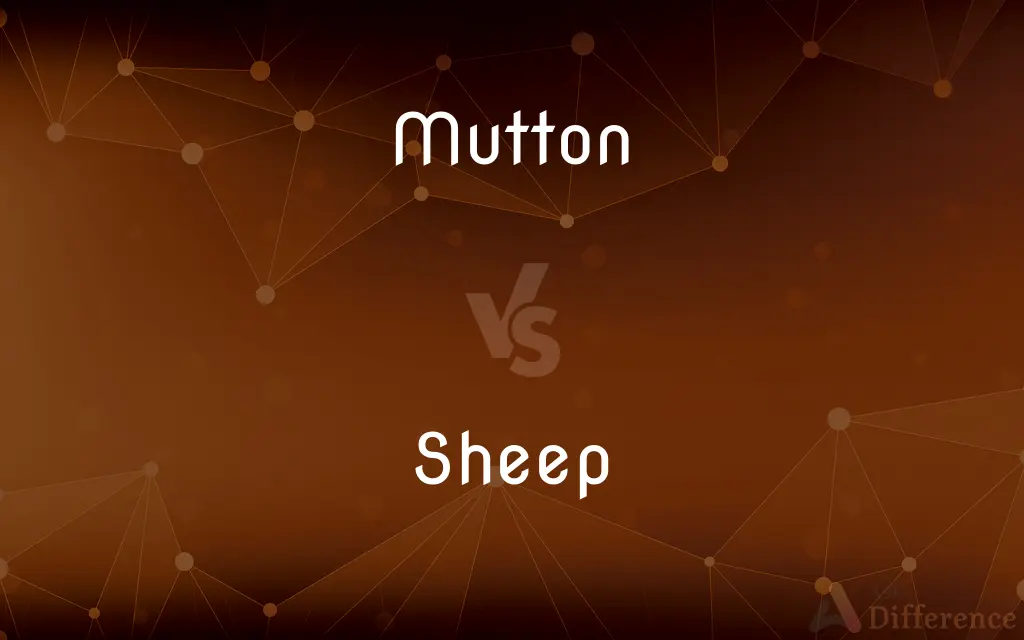Mutton vs. Sheep — What's the Difference?
By Urooj Arif & Maham Liaqat — Updated on March 9, 2024
Mutton refers to the meat from a mature sheep, known for its strong flavor and tough texture, whereas sheep are domesticated animals raised for wool, meat, and milk, with "mutton" specifically describing meat from those over a year old.

Difference Between Mutton and Sheep
Table of Contents
ADVERTISEMENT
Key Differences
Mutton is the culinary term for meat from sheep that are generally older, typically more than two years of age. This meat is characterized by its deep red color, pronounced flavor, and a firmer texture compared to lamb, which is from younger sheep. Sheep, on the other hand, are versatile domesticated animals kept for various purposes including their wool, meat (lamb and mutton), and milk. The distinction between mutton and sheep highlights the specific use of the animal versus the animal itself.
While mutton is appreciated in many cuisines around the world for its rich flavor, it requires longer cooking times to tenderize, making it suitable for slow-cooked dishes like stews and curries. Sheep, in their role as farm animals, are bred for a range of characteristics including wool quality, meat yield, and milk production, depending on the breed and the farmer's focus.
The term "mutton" is often associated with traditional and cultural dishes, particularly in South Asian, Middle Eastern, and European cuisines, where it is celebrated for its depth of flavor. The farming of sheep, conversely, is a significant agricultural activity with historical and economic importance, contributing to the livelihoods of farmers and communities, particularly in regions suited to pastoral farming.
Mutton's nutritional profile includes being a good source of protein, vitamins, and minerals, though it is generally higher in fat and cholesterol than lamb. The management and care of sheep, including their diet and environment, play a crucial role in the quality of the wool, milk, and meat (including mutton) they produce.
Both mutton and sheep are integral to sustainable agricultural practices in many parts of the world. Mutton production utilizes older animals, often after their productive years in wool or milk production, contributing to the circular economy of livestock farming. Meanwhile, sheep farming, including the raising of animals for mutton, supports biodiversity, land management, and rural economies.
ADVERTISEMENT
Comparison Chart
Definition
Meat from mature sheep, over two years old
Domesticated animals raised for wool, meat, and milk
Characteristics
Strong flavor, tough texture, requires slow cooking
Various breeds with different qualities for wool, meat, milk
Culinary Use
Appreciated in slow-cooked dishes for its rich flavor
Source of both lamb (young sheep meat) and mutton
Age
Typically from sheep older than two years
Can range from lambs (under 1 year) to mature sheep
Economic Role
Part of traditional cuisines, valued for specific dishes
Important in agriculture for multiple products and land management
Compare with Definitions
Mutton
Meat from a sheep over two years old, known for its distinctive flavor.
The chef slow-cooked the mutton to make it tender for the stew.
Sheep
Come in various breeds, each with unique characteristics.
Merino sheep are highly prized for their fine, soft wool.
Mutton
Requires longer cooking times due to its tougher texture.
The mutton was marinated overnight and then simmered for hours to enhance its taste.
Sheep
Domesticated animals raised for wool, meat, and milk.
The farmer's flock of sheep provides wool for textiles, in addition to meat and milk.
Mutton
Often used in traditional dishes across various cultures.
Mutton biryani is a celebrated dish in South Asian cuisine.
Sheep
Integral to agricultural communities and economies.
Sheep farming is a cornerstone of the rural economy in the region, supporting many families.
Mutton
A byproduct of mature sheep, contributing to sustainable farming.
Utilizing mutton from older sheep aligns with sustainable agricultural practices.
Sheep
Managed for environmental sustainability and land management.
The sheep graze on the hillsides, helping to manage the landscape and prevent overgrowth.
Mutton
Valued for its nutritional content, albeit higher in fat.
Mutton is a good source of protein, though it's richer in fat than lamb.
Sheep
Source of both lamb and mutton, depending on age.
The young sheep will be raised for lamb, while the older ones will eventually be used for mutton.
Mutton
The flesh of fully grown sheep.
Sheep
Sheep (Ovis aries) are quadrupedal, ruminant mammals typically kept as livestock. Like all ruminants, sheep are members of the order Artiodactyla, the even-toed ungulates.
Mutton
The flesh of sheep used as food.
Sheep
A domesticated ruminant mammal (Ovis aries) having a thick coat, raised in many breeds for its wool, edible flesh, or hide.
Mutton
The flesh of goat used as food.
Sheep
Any of various wild ruminant mammals related to and resembling the domestic sheep, such as the aoudad, bighorn sheep, and mouflon.
Mutton
(archaic) A sheep.
Sheep
Leather made from the skin of one of these animals.
Mutton
Em, a unit of measurement equal to the height of the type in use.
Sheep
A person regarded as timid, weak, or submissive.
Mutton
A prostitute.
Laced mutton
Sheep
One who is easily swayed or led.
Mutton
(historical) An old Anglo-French gold coin impressed with the image of a lamb.
Sheep
(countable) A woolly ruminant of the genus Ovis.
Mutton
(Cockney rhyming slang) deaf.
Sheep
The domestic Ovies aries, the most well known species of Ovis.
Mutton
A sheep.
Not so much ground as will feed a mutton.
Muttons, beeves, and porkers are good old words for the living quadrupeds.
Sheep
(countable) A timid, shy person who is easily led by others.
Mutton
The flesh of a sheep.
The fat of roasted mutton or beef.
Sheep
A religious adherent, a member of a congregation or religious community (compare flock).
Mutton
A loose woman; a prostitute.
I willingly return to my muttons.
Sheep
(uncountable) Sheepskin leather.
Mutton
Meat from a mature domestic sheep
Sheep
A person who is easily understood by a speech recognition system; contrasted with goat.
Mutton
The square of a body of any size of type
Sheep
Any one of several species of ruminants of the genus Ovis, native of the higher mountains of both hemispheres, but most numerous in Asia.
Sheep
A weak, bashful, silly fellow.
Sheep
Fig.: The people of God, as being under the government and protection of Christ, the great Shepherd.
Sheep
Woolly usually horned ruminant mammal related to the goat
Sheep
A timid defenseless simpleton who is readily preyed upon
Sheep
A docile and vulnerable person who would rather follow than make an independent decision;
His students followed him like sheep
Common Curiosities
Are all sheep raised for mutton?
Not all sheep are raised specifically for mutton; many are raised for their wool, milk, or lamb meat. Mutton usually comes from older sheep that are no longer productive for wool or breeding.
What are the nutritional differences between mutton and lamb?
Mutton is generally higher in fat and has a richer flavor compared to lamb, which is tender and has a milder taste. Both are good sources of protein, vitamins, and minerals.
Can mutton be used in the same recipes as lamb?
While mutton can be substituted for lamb in many recipes, adjustments in cooking time and method may be necessary due to its tougher texture.
What makes sheep farming important to rural economies?
Sheep farming provides essential products like wool, meat, and milk, supports employment, and contributes to the cultural and economic fabric of rural communities.
How does the diet of a sheep affect the taste of mutton?
The diet can significantly influence the flavor of mutton, with grass-fed sheep typically producing meat with a more nuanced taste compared to those on a grain-based diet.
Is mutton environmentally sustainable?
Mutton can be part of sustainable farming practices, as it uses older animals that have often already contributed to wool or milk production, reducing waste and promoting a circular economy in agriculture.
How does the age of the sheep affect the quality of the wool?
Generally, younger sheep produce finer, softer wool, while the wool from older sheep can be coarser, affecting its use and value in textiles.
Why is mutton less popular than lamb in some countries?
Mutton's stronger flavor and tougher texture make it less appealing to some palates, and it requires longer cooking times, which may not suit fast-paced lifestyles.
Can mutton be as tender as lamb if cooked properly?
Yes, with proper cooking methods such as slow roasting or stewing, mutton can be tenderized and made delicious, albeit with a different flavor profile than lamb.
How do sheep contribute to land management?
Sheep grazing can help control brush and weeds, reducing fire hazards and maintaining open lands, which benefits the ecosystem.
Share Your Discovery

Previous Comparison
Ideal vs. Ideology
Next Comparison
Response vs. ReactionAuthor Spotlight
Written by
Urooj ArifUrooj is a skilled content writer at Ask Difference, known for her exceptional ability to simplify complex topics into engaging and informative content. With a passion for research and a flair for clear, concise writing, she consistently delivers articles that resonate with our diverse audience.
Co-written by
Maham Liaqat














































